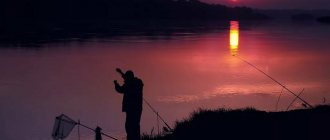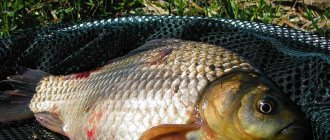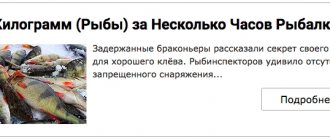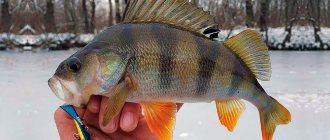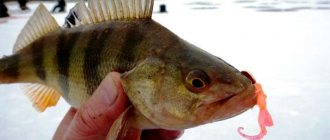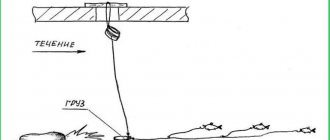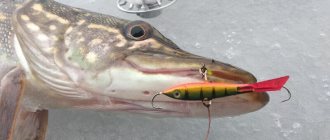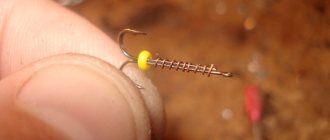Yuri 07.10.2020 494
As soon as the evening dawn ends, most fishermen immediately pack up their gear and head home. Some hunters prefer, of course, to stay overnight fishing, so as soon as it gets dark, they disperse to their tents for the night so that they can continue fishing in the morning. But in fact, night fishing is an incredibly interesting activity and no less productive than during the day. But today I will tell you about how to catch perch at night, I will share the subtleties and nuances.
How to determine a place for fishing at night?
There are certain patterns for night fishing. First of all, these are depths. The predator will most likely stay on the shallows, where the depth does not exceed 2 m. It’s great if there are ambush areas, rifts and exits from holes nearby. In general, it would be a good idea to do some reconnaissance before such fishing. Having looked at a promising place during the day, you should stay overnight. Strong splashes in the shallows will give away a hunting predator. You should also take into account that night is not suitable for walking fishing, so the section of the river where you are going to fish should be at least 100-150 meters long without any obstacles or high vegetation. You need to study it during the day to avoid injuries, snags and other troubles. Successful fishing during the day will also tell you where to fish. It is unlikely that a predator will go far from this place in the evening.
Lighting for catching predators at night
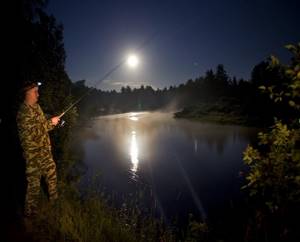
Catching a predator at night
It’s great if the process takes place on a clear moonlit night. Its light will allow you to navigate the selected area, but if it is cloudy and there is no moon, then you should use a headlamp. Without it, you won’t even find what you need in your bait box. You can also light a small fire on the shore; in addition to the reflections on the water, it will allow you to warm up if it’s cold and boil tea.
Where to Hiccup Perch in Glukhozimye
In January and February, the tactics of searching for perch change dramatically, as do its habitats. In the dead of winter, perch, like any other fish, is passive. It moves little, is found in deep places, with snags, grass, stones or any irregularities at the bottom.
If at any other time, perch can be lured by playing bait from a distance of tens of meters, then in the middle of winter such a trick will not work.
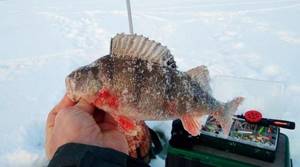
The search radius for perch in the wilderness is greatly reduced; holes are drilled from each other at a distance of no more than 2 meters. In a word, the bait must be placed right under the perch’s nose, only then can you count on results.
In addition, when you find a perch, it would be useful to feed it. Basically, a feed bloodworm or jig is used for this. Important: complementary foods of animal origin.
3 ways to improve your fish bite!
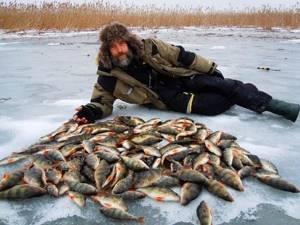
Over 15 years of active fishing, I have found many ways to improve the bite, and here are the most effective:
1. Bite activator . This pheromone additive attracts fish most strongly in cold and warm water. The Fish Hungry bite activator has proven itself to be excellent - Read more…
2. Tackle with increased sensitivity . You should first familiarize yourself with the features of using a particular type.
3. Pheromone baits . They attract the attention of fish, stimulate hunger and cause a schooling reflex, which allows you to collect a lot of fish in one place.
You can get the rest of the secrets of successful fishing for free by reading my other materials on the site.
3 ways to improve your fish bite!
Over 15 years of active fishing, I have found many ways to improve the bite, and here are the most effective:
1. Bite activator . This pheromone additive attracts fish most strongly in cold and warm water. The Fish Hungry bite activator has proven itself to be excellent - Read more…
2. Tackle with increased sensitivity . You should first familiarize yourself with the features of using a particular type.
3. Pheromone baits . They attract the attention of fish, stimulate hunger and cause a schooling reflex, which allows you to collect a lot of fish in one place.
You can get the rest of the secrets of successful fishing for free by reading my other materials on the site.
Features of casting with a spinning rod at night
For an inexperienced fisherman, night fishing will be very difficult. You need to have a great feel for the spinning rod, fishing line, bait, and be able to imagine how and where it will fall after casting.
At night, long casts are not needed; it is enough to throw the bait no more than 15 meters. One day my partner, fishing already at dusk, and even among dense tall bushes, sent a wobbler forward with a brave flourish. It was on a small forest river. The bait quickly flew over it and crashed into a stump standing on the other bank. At the end of the braid there was only a ring with which the wobbler was attached.
An angler planning to go night fishing must be confident in his skills in handling a spinning rod.
Secrets of fishing
If I use a float rod or donka to catch perch, then I use special floats.
- Interesting! Previously, fishermen used only flashlights and lamps when fishing at night in order to somehow notice the bite.
Now in any fishing store you can pick up special floats that glow well in the dark. These inventions are disposable and quickly solve the problem of night visibility. In addition, such small devices are quite cheap, so everyone can afford them.
The firefly comes complete with a small tube that fits onto any float, regardless of its shape and parameters.
But now you can even order special floats with built-in luminous systems. They shine throughout the night, are quite bright, they can be seen even at a short distance and do not scare away freshwater inhabitants.
- Important! If you don’t skimp on fishing accessories, then immediately order a high-quality alarm that will notify you loudly enough about night bites.
I also always take several bottom fishing rods with me. And in order to hear about the bite, I attach a bell to the tackle. This is a fairly reliable option. I've never missed my catch like that. But there is a small disadvantage of using a bell: it does not ring very loudly, so at night you need to constantly be near the pond or listen to every rustle.
Recently I specially ordered another bottom fishing rod with an automatic hooker. Incredibly convenient device. As soon as the perch begins to actively peck, the fishing rod is triggered and immediately hooks the inhabitant of the reservoir. Firstly, I immediately notice and hear perfectly that the fishing rod has worked. Secondly, the fish is already securely hooked on the hook: even if I don’t make it in time for the bite, I’ll still pull out my own catch.
If this is your first time going night fishing in Sazanya Bay, then take with you a miracle of modern technology - an electronic alarm. It is so loud that it is simply impossible not to hear it. Outwardly, it looks like a small box that serves as a holder for gear. As soon as the fish bites, the device immediately lights up and starts beeping loudly. Modern models of such devices are already equipped with a special regulator, through which you can set the volume level.
With the right tools and gear for night bass fishing, you're sure to come home with a decent catch.
TAGS:
Night fishing gear
At night it is better to fish with light sticks, leaving the ultralight at home. Of course, every experienced fisherman has his own preferences, but a general overview can be made. The sninning length is approximately 2.5 - 3 meters. Construction - average. Test from 5 to 25 (30) grams. The reel is inertial, a large reserve on the spool is not necessary. Line or braid? If there is a fishing line, then at least 0.2-0.25mm, a safety margin will not hurt. Braid – 0.12-0.16mm.
The tackle must be adjusted and the fisherman must feel it well.
Night fishing for bream in winter
Among winter fishing enthusiasts, bream rightfully occupies one of the leading positions. This includes searching for fish sites, selecting the right bait, and fine-tuning the gear.
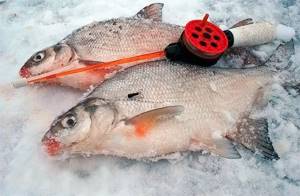
Night fishing is considered especially exciting, especially since it is at night that the largest specimens are most often caught. At the same time, night fishing requires the angler to have some experience.
Choosing a fishing spot
You can have excellent bait, good tackle - but, nevertheless, be left without a catch if there are no fish nearby or if this place is not suitable for bream camps. Night fishing also brings its own specifics: if the choice of place during the day is unsuccessful, changing it at night is very difficult, sometimes almost impossible. Therefore, it is better to arrive at the reservoir in advance so that you have at least 2-3 hours of daylight to search for promising fishing spots. In reservoirs, bream (especially large individuals) prefers coastal and pre-channel edges, dumps in pits, flat plateaus near pits and dumps, and shallow places (with a decrease in pressure). When the atmospheric pressure is low, you need to choose places where it is shallower, when it is high, where it is deeper. The most promising depths will be from 3 to 15 meters, with an average of about 7-8 meters. The search for such places can be done using a navigator, a depth map and local landmarks, or according to the stories of other fishermen, but still the most accurate picture can be obtained using a depth gauge or echo sounder. After finding promising places, it is necessary to make several clarifying measurements to determine the boundaries of the hole or plateau, the direction of the decline, etc. Once you are finally convinced that your choice is correct, you can move on to parking equipment.
Parking equipment
The first thing to do is to drill three holes in the ice (with a diameter of at least 150 mm), then set up the tent so that the wind blows at the back, and at the edge of the tent, and not at one of its sides. In strong gusts of wind, this will allow the tent to remain stable. In addition, the edges of the tent should be sprinkled with snow so that there is less blowing from below and the tent stays warm longer. Inside the tent we place a box opposite the holes, place the ice auger along the wall of the tent on the left hand, and the scoop on the right. Behind the drawer you can put various things. We place gas equipment in front of us, behind the holes, and hang the lantern above our heads in the center of the tent or on a stand to our left. For heating in a tent, it is best to use a catalytic gas stove. It is better to avoid open flames (for example, candles) - they quickly burn out the oxygen inside the tent. It is also better to use gas equipment from time to time - for example, to heat food or water for tea or coffee.
Feeding the holes
After setting up the tent, we feed the fishing spot using a feeder with bloodworms (clean or with dirt) or bloodworms in combination with special winter bait (“Winter Mix”, “Feeder Fish. Winter”, “Super Fish. Bream”). For one fishing trip you will need approximately 1.5-2 kg of bait, of which about 1 kg will be bloodworms. Having fed, we begin to deploy the gear.
Notes on preparing bait:
- Boiled millet is mixed with the dry mixture before use, i.e. already on the pond, just before adding water to the bait.
- All cake components (seeds, peanuts) are fried in the same way as for food. Then they are finely ground in a meat grinder or chopper.
- You can mix all the ingredients, except millet, at home.
- To mix and soak bait on a pond (this needs to be done specifically on a pond), it is better to have a special container - a bucket or bag.
- The essence is introduced into the bait in a very small amount. This can be done either in a pond while soaking, or at home.
- The bait is moistened with water from the lake to the desired condition.
- It is acceptable to add bloodworms to the bait. This will improve the action of the bait and increase the likelihood of catching large fish. The more bloodworms, the better. You can also feed pure bloodworms, but this is a rather expensive component.
- When feeding by hand, the bait is additionally waterlogged and the balls are molded into the most even balls possible.
Tackle and fishing technique
Typically, for such “sedentary” fishing, two “passive” float rods and one “active” jig are used.
In “passive” gear, the nozzle is in a stationary position at the bottom. Moreover, it can be either a float fishing rod or a fishing rod equipped with a nod. This gear is assembled like this: take a winter fishing rod with a reel or reel, and wind up a fishing line with a diameter of at least 0.12 - 0.14 mm and a length of up to 30 meters. Then either the rod is equipped with a nod, or a float is hung on the fishing line.
If a nod is used, when unloaded it should be slightly bent upward, and when loaded it should take a horizontal position. This way the nod tuned will react sensitively to typical bream bites with the bait being lifted from the bottom. At the same time, the nod will work well when stretching, bending towards the water. When using float equipment, either two floats are used, located on the fishing line at some distance from each other, or double floats, the two parts of which are connected by a hinge. In both cases, the top float (top of the float) must be smaller than the bottom. A more convenient option is the second one (with a double float on a hinge).
After lowering the jig to the bottom, the float should be under water at a distance of 5-7 mm from the surface of the water. After the bite, when the bream lifts the jig with the nozzle from the bottom, the float will rise up and its upper part will lie horizontally.
If you use a rig with two floats, the top float will come out of the water and lie horizontally. In both cases, at this moment it is necessary to make a sweep, just as in the case of bending the nod upward. It may happen that the bite will be expressed as a stretch - that is, when the nod bends towards the water or the float sinks further into the water. These are also sure signals for hooking. As for the third - “active” - tackle, it is usually a jig tackle equipped with a slightly thinner fishing line - about 0.11 - 0.12 mm.
As for jigs, tungsten “drops”, “uralkas” and “ovsinki” are best suited here - for both types of fishing, as well as micro-balancers, “witches”, “devils” and “devils” - for active fishing, weighing from 4 -6 g for bodies of water without current (lakes, reservoirs) up to 10-12 g for rivers. From 3 to 11 bloodworms are placed on a jig hook.
Time for winter bream fishing
The best bream bite is usually observed on the first ice or on the last ice. Also, during the winter, a good bream bite occurs if there are no severe frosts for some time. The main number of bites is observed from 16:00 to 18:00, as well as from 23:00 to 2:00-4:00. The second exit of fish for feeding (at night) is the main one.
After hooking a bream, you should try to tear it off the bottom and remove it from the school so as not to scare it. Then, quickly pull it up to the ice and carefully insert it into the hole. It’s also not worth it to force the fishing excessively: a large bream may well break off the thin fishing line with the next jerk. It is important to keep the line in tension all the time, gradually removing it from the water, and control all movements of the fish. Then the golden, wide-backed beauty will definitely be in your hands.
Lures for catching predators at night
The color of the bait at night does not matter; its behavior in the water is decisive. The more noise it makes, the more likely it is to bite. Let's look at which baits you can use to catch which fish.
Wobblers, cranks. Chub and asp respond well to them at night. Since the depths where fishing takes place are shallow, the bait should not go too deep and float up quickly. It is also worth using poppers; perch can also attack them.
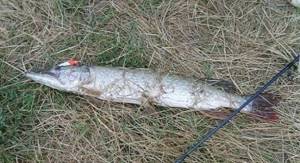
Pike at night on a wobbler
Jig, turntables. Pike can be attracted to silicone and rotating lures. Only turntables should be at least No. 5, and jig baits from 3 to 7 cm. In autumn, the size should be increased.
Also, pike perch can bite well on wobblers, but it is better to use a jig with glowing rubber on it. A catfish can also react to it.
Using small spinners, you can catch perch.
First, it is better to fish your area, using small baits in the hope of getting bites from perch, chub and asp. After this, you should move on to heavier baits and try to catch a larger predator.
When does the perch bite: the best time and weather for fishing
The secret to a good catch has been revealed, just pour 1/4 of a slice into the water...
To successfully catch perch, every amateur angler must know better the time when this predator actively bites.
The most successful catching of perch is in early spring (early March - mid-April), almost the entire summer season and in the fall (a good bite is observed mainly in October-November).
As a rule, immediately after ice drift, this predator begins to actively hunt, grabbing any bait that moves (this season you can easily catch it with small spoons, such as a wobbler or spinners).
Quite often, biting activity can be influenced by weather factors (rain, sudden changes in air temperature, strong wind, etc.) to which the perch reacts quite strongly. Also, a predator may practically not peck for a long time during a sharp change in the lunar phase.
A good bite is observed during the spawning period , which takes place around the end of March and beginning of April.
Quite often, when fishing with a spinning rod at this time, it is possible to catch a fairly large predator weighing more than 1-1.5 kg.
In summer, perch most often bites quite weakly, so to catch it, it is recommended to constantly experiment with different baits, choosing the one that is more catchy.
Active biting of the predator in summer is observed in early June and continues until approximately mid-July.
At this time, the predator prefers to peck on bright baits, the most popular of which are multi-colored wobblers that imitate the movement of a real fish.
On the warm, sunny days of July, perch quite often bites both on artificial bait (spinners) and on live bait, which is used as small crucian carp or carp.
The best time for catching perch in the summer is early morning (from 4-5 to 7-8 o'clock), lunch (11-14 o'clock), as well as evening (after 18-19 o'clock), when the fish are actively coming out to hunt.
In autumn, perch fattenes up, and the biting activity varies. In early September, the predator can be successfully caught using many baits, including live bait.
In October-November, the perch begins its autumn feeding season, during which the predator behaves quite aggressively, grabbing any bait that moves.
You can catch perch almost all day in the autumn, but, nevertheless, in the morning and afternoon the bites are a little better.
Quite often, perch bites much more actively after rain, after which it likes to have a good hunt for live bait.
To successfully catch a predator in the fall, you can use bright, small or medium-sized spoons, which can be artificial bait (spinners, twisters, vibrotails), or well-known wobblers.
Many fishermen successfully catch perch in winter. Winter fishing is significantly different from summer fishing, but it also has its advantages.
In winter, perch are more actively caught during the day, but sometimes the bite increases in the evening, depending on weather conditions.
As a rule, in severe frosts the bite is significantly reduced, but on warmer days, perch most often actively hunts, so it can be easily caught both with artificial bait (spinners) and with live bait.
When going fishing, it is recommended to take into account the influence of both weather conditions and the lunar phase in order to successfully catch this predator.
The fish will immediately feel on the hook if you smear it with thick...
Retrieving and hooking for night fishing
The bait is cast across the current. As it is demolished, wiring begins. It is difficult to determine which type of fish will like which wiring, so they should be changed. It is recommended to start by pulling the bait with the tip of the spin and then reeling it in. The line should always be in tension, as sometimes the bite can be barely noticeable. In general, you need to react by cutting to all the incomprehensible sensations that are transmitted to the hand. It’s better to make one more mistake than to sleep through a real bite. The hook should be sharp and with a large amplitude, which will allow you to pick up the slack in the fishing line and detect the predator. This is especially true when biting pike perch, which has a very hard mouth.
Behavior of perch in the middle of winter
Ice-bound water is low in oxygen, which negatively affects the well-being of underwater inhabitants. Perch is no exception. Under such conditions, its activity decreases so much that sometimes it almost completely stops feeding. In addition, striped fish are preparing for spring spawning, so they save energy for this important event and move around little. In other words, during the dark winter period it is not only difficult to force a predator to bite, but even easy to find. It turns out that two problems need to be solved at once, otherwise there will be no result.
Unfortunately, even finding a school of perch is not a guarantee of success. Many fishermen who use an echo sounder for fishing have more than once encountered a situation where the device showed predators standing in a dense wall, but they did not react to the bait at all. And for a variety of different ones, both artificial and living. Here it is, a fish, two or three meters under the ice, but there’s no point in it. We have to pick up the ice screw again and look for another flock that is showing at least some activity.
